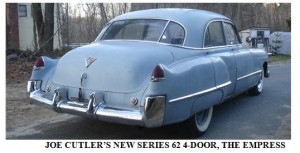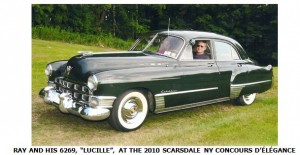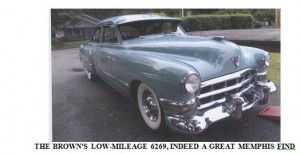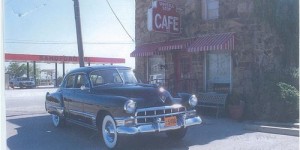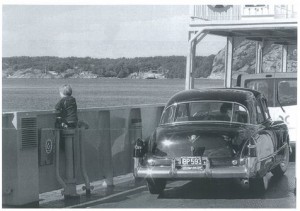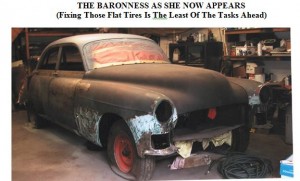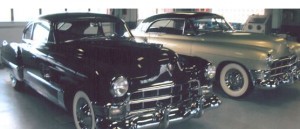[Ed. Note: Following the sale of his gorgeous 4-door, the Baroness, Prez Joe Cutler has been continuing the resurrection of his newly acquired 37,000 mile, original 6269 sedan from Colorado, The Empress.]
Joe writes: “We wet sanded the recently re-painted hood, firewall and dashboard with 2000 grit and buffed out the pieces. I masked off the hood & freshened up the under-carriage with new undercoating. My glass man swung by and installed the brand-new driver’s side windshield, and my auto body man helped me re-install the hood. Lookin’ great!
I also re-wired the back-up lights–they work perfectly—and eliminated the electric fuel pump the previous owner installed so the car will run off the original rebuilt mechanical pump.
Now for the bad news. (I thought things were going too well so far!) While running the engine and getting ready to time it, I (thank God) happened to notice the reflection of light off something shiny on the garage floor. I looked underneath the car and discovered, much to my surprise and horror, a massive puddle of fresh oil under the rear parts of the engine! I thought the rear main seal let go, as over a quart of oil was pumped out onto the floor in a matter of minutes. Luckily it turned out to only be a loose fitting where the oil pressure gauge tube screws into the upper rear of the motor, which was a great relief. Just another obstacle to overcome, and there’s been loads of those this year with all the cars! The car now runs like a Swiss watch! Here’s a recent photo
Category Archives: Series 62
HAVING A BALL WITH LUCILLE
Lucille came into my life at a good time. I was feeling aimless and a bit down and she gave me a reason to get my thoughts together and gather up my tools. I don’t know why I named her Lucille; it just felt right. Someone I know suggested I call her Greta. He said it felt right; well, maybe for him. Let me tell you a bit about this beauty so you’ll understand how I got hooked.
I’ve admired the designs of Harley Earl since I was a kid. For the last 60 years, however, I didn’t know his name, just his sense of design. I narrowed down that I wanted a Harley Earl designed car and more specifically, a Cadillac. I narrowed down the years to about 1948 or 1949. The design and mechanics of those years to me were special to me. I chose 1949 since that was the year that the new V8 engine replaced the old flathead design. It introduced greater efficiency and horsepower while reducing the weight and size of the engine.
I Googled “1949 Cadillac” and one of the available choices mentioned that it was in Scarsdale, New York, a Westchester County suburb of New York City not far from my home in Patterson, NY. When the picture opened, I saw this beautiful dark green Cadillac parked on the streets of Scarsdale. The shape, design, color of the Series 62, 4 door sedan all but swept me off my feet. Oddly enough, it had a special New York license plate that said ‘HYDRMTIC’. I found that unusual. Why would anyone advertise that their car had an automatic transmission? To each his own. As days passed, I returned to that page repeatedly. I found that the car had been one of those participating in the Scarsdale Concours d’Elégance back in 2005. Well, we all have dreams and this was mine.
As I got more serious about actually buying an old car, I saw an ad in Hemmings Motor News offering a 1949 Caddy in that same nearby Westchester County. Well, that was close enough to be able to check out a car before buying. Previously, I had put in a winning bid on Ebay for a 1949 Caddy in Maine. The reserve was not met and I didn’t get that car, although the seller later contacted me about making a deal. As we exchanged emails, more and more faults of the car came out and I backed away from any deal. Now, looking back at that car, I was lucky not to get it.
I contacted the seller of my Hemmings’ Westchester County car who answered many questions and agreed to send pictures. When I opened the pictures on my computer, I saw that the car’s license plate read, “HYDRMTIC”. Wow! I had stumbled across my dream car. Fortunately, the price was excellent and I just agreed to it. The seller was a financial advisor with an impressive large, old home. He had bought this car 10 years ago at an auction at Lyndhurst Castle in Irvington, NY conducted by Christie’s Auction House. He showed me the published Christie’s booklet showing all the cars entered in this auction, including this beauty. Wow, this car was being sold with other fantastic cars whose values were estimated up to $750,000 by Christie’s. While this car’s value was a mere fraction of the value of the others, I felt it was sitting in good company.
The seller said that his interest in the car had slowly diminished and he wanted something newer. He provided great paperwork with the car, including the actual California license plate on the car when he got it, a copy of the owners’ manual, shop manual, original ‘build sheet’, data sheet, accessories brochure, loads of General Motors paper and some spare parts for the car. Time to clear out the garage!
I wound up completing the purchase and received the Christie’s booklet and the actual auction paddle used by the seller ten years ago. He also supplied ten years of receipts for repairs and purchases for this car. From the information on the paperwork, it was easy to see that he had put about 2,000 miles on the car in ten years (that’s an average of only 4 miles per week!). The car’s finish isn’t perfect and it needs some mechanical attention; however, I’m in love with Lucille and hope to show it off when gathering with my fellow members of the Cadillac-LaSalle and Lambda Car Clubs.
RUST BEHIND THE ROCKER PANEL MOLDING
Hi everyone. I know I am a new-comer and that there are many people who are very experienced about working and restoring ’49 cars. But I would like to give a little contribution even if, probably, many of you already know what I am talking about.
Taking apart my car I came to the lower chrome molding. I took it apart and then I took off the retainer metal strip. Really a lot of dirt and mud came out from the space between the retainer and the body and the retainer and the chrome. Probably this is a kind of mud trap which can be harmful for both chrome and body metal, especially if you drive your car all year round and in bad weather. Too bad I did not take a picture when there was all that mud around. Better, maybe, to periodically have a look at this spot once in a while as rust may be developing there. Hope this little tip can help someone.
FINDING A 49 IN MEMPHIS, TENNESSEE
On Saturday, October 10th, 2009, we drove to Memphis (from N. Little Rock, Arkansas) to take a look at a ’49 Caddy Series 62 4-door, Baby Blue in color. We had been told about it by a fellow car club member. The car was bought new in that city, and has been a Memphis car its whole life. We saw it, thought it was gorgeous, had our minds made up and, needless to say, we left Memphis with that ’49 Cadillac.
We bought it from the third owner of the vehicle, and they had purchased it in 1989 when it had 62,000 miles on it. It now has 67,000 miles and is rust-free. The interior seats are completely original, the carpet has been replaced at one time, but since Tom is in the auto upholstery business we will have that restored. Fortunately, he put it up on the lift at the shop the following Monday and found that the right rear shock had all but come loose, so new shocks were ordered immediately. Probably the best part of buying a car for us is restoring it to as near the original as possible. We are looking forward to getting it ready and going to the Cadillac Grand National Meet in 2010
THE RESTORATION OF MY 49
I acquired my 49-6207 in June/July of 2007, commenced the restoration process in February 2008 and completed it in September 2009. In actual fact the story is much longer than that. My very first car was a 1940 LaSalle in high school and later I had other cars, but underneath all was a fascination with 1948 and 1949 Cadillacs, especially the Club Coupe. As a college student an older neighbor had a 48-6207 in dark green metallic, which was always pristine with its wide whitewalls, Sombreros and “Rainbow” dash. Though I lusted after that car, it was never for sale, so life moved on. “It” was “sacrificed” on the altar of wives, kids, houses, careers etc., but that’s when “it” started.
As the years went by that iconic 61/6207 Coupe “stuck” in my head, so I scanned the magazines for interesting candidates, but most were too far away or too something. Then I came upon a ’49 6207 close to home in Sandy, Oregon, which demanded investigation. Its second owner, a 75 + year old gentleman, had purchased it from the estate of its original owner in California over thirty years before. Anyhow, he determined that I knew a bit about Cadillacs and would not make it into a Street Rod but, sadly, the price was too high. Less than a month later I received a call from him stating that he had sold his house and was retiring to Idaho. The price for car and many spare parts was too good to let go and was conditional upon my “swearing” not to make a mess of the car.
Before I began the restoration, I re-joined the CLC and purchased the shop and authenticity manuals for the car, which I strongly recommended to anyone commencing a restoration. The “49ers, especially Joe Cutler, bailed me out of numerous detailed sticking points, as well as Cliff Houser (locally) whose French Grey 49-6207 is featured in “Cadillacs of The 40s”. Also, Ed Cholakian helped fill many Steele rubber orders and sort through pesky details like non functional fuel pumps, wiper motors and others.
The actual process began with media blasting the car to bare metal. There was no rust but the “dryness’ had a down side as all the rubber parts were done for. Though the body was damage free, there was a fair amount of effort devoted to clearing up the many little dings, ripples and such. Research in the first edition of the Authenticity Manual showed that the cowl tag paint number indicated the original color was # 16 “Lucerne Green –Metallic”, of which samples were discovered beneath some undercoat in the rear fender wells. This was replicated with especial care and attention given to getting the metallic aspect correct for 1949 with DuPont Chroma Base Coat-Clear Coat urethane.
Then it was time to look at the interior, which coincided with the publication of the 2nd edition of the Authenticity Manual. Luckily for me, the manual had numerous detailed shots of a ’49 with the same interior option, #43, as mine; that being Chocolate Brown wool broadcloth with taupe Bedford Cord. SMS in Portland OR was not only able to furnish the correct upholstery, but the correct brown “vinyl” for the package tray, rear seat backs, front kick panel and door arm rests. The trunk was another matter, as no one locally could relate to the “Oyster” colored hopsack pattern material. But the value of the Club came through again, as Joe Cutler and I traded some parts I had for this material. The rest is history.
The engine was not rebuilt, as it had been done less than 17,000 miles before, though it was in serious need of a complete tune up. I thought the transmission was bad due to hard shifting, but this was due to the fluid level being 3 quarts low and the carburetor “kick-down” rod being totally out of adjustment. A ‘49 Times article and the Shop Manual sorted these out. The “slow starter” was due to an incorrect (too small diameter, 12 volt?) positive battery cable which was corrected, along with a new starter solenoid. The 6 volt starter now gets the job done. It’s amazing what happens when you use the correct parts. So now I have a good-running example of a 49-6207. The previous owner contacted me to offer his family’s approval for bringing the car back to its intended level.
Modesty aside, I’m pleased with the outcome. Again, it could not have been achieved without the help of a lot of people within CLC and the ‘49ers. Even in a sad state these cars are beautiful iconic design pieces. Hopefully this one can take its place among the other great examples that helped me through the process.
JIM AND DARA WARREN’S BEAUTIFUL 6269 4-DOOR MISS DAISY PARKED IN FRONT OF THE WHISTLE STOP CAFE IN DECATUR TEXAS
A 49 IN SWEDEN
Chapter member Lars Pettersson now lives in County Galway, Ireland but owns a ’49 back home in Sweden. Lars writes that it’s a “4-door, Series 62 Touring Sedan, black, with 42,363 original miles as of April 2008”. The photo below shows Lars’ car on a ferry crossing a Swedish fiord at Lysetil. The little boy, naturally, is much more interested in the water than the car. He’ll see the light when he’s older!
MY COURTSHIP WITH THE BARONESS
It all started innocently enough, as many “romances” do. In October, 2008 I decided to drive my ‘49 Club coupe, The Duchess, to the annual Cadillac Day held at Norwood Cadillac in Norwood, Mass. It was a picture-perfect New England fall day, resulting in a large turnout of vintage Cadillacs and LaSalles.
As I sat by my car enjoying the festivities and the last vestiges of the old car season, an older gentleman approached and struck up a conversation. He obviously liked my car, mentioned how he had always loved the 1948-49 “fastback” coupes, and said he owned a 1949 Cadillac Series 62 4-door sedan that he was considering sending to the crusher. He further explained that while the car had lots of rust-out, it did have many new parts, including brand-new rear leaf springs and shackles as well as a new battery box, that the water pump, carb and generator had been rebuilt, and that it ran and shifted perfectly. The die was cast; I obtained his address and promised I’d take a “look” at it the next day.
I arrived at the appointed time, and as I drove up his driveway I caught my first glimpse of “Her” sitting forlornly beside his garage. I was anxious to examine this derelict, and wasted no time doing the requisite “walk-around”, opening the hood, doors, trunk and peering underneath. She was indeed a rusty one: the “tin termites” had enjoyed an all-you-can-eat buffet, in the process devouring both inner and outer rocker panels and the bottom front and rear sections of the front fenders. The rest of the body had ample surface rust and peeling paint, but the intriguing aspect was that this appeared to be a totally original unmolested car, right down to its original paint, Avalon Grey. In addition, amazingly enough, the doors were rock-solid as was the trunk and, except for the front corners, the floors. He started her up and the engine sounded strong. A lot of accessories still worked, including all the interior lights, and the car was 100% complete, right down to the original washer bottle and perfect vacuum antenna sitting in the trunk.
He wanted $1,000 for it, but when I waved $800 cash under his nose the deal was done. The next weekend a fellow Cadillac enthusiast and I brought her home on a trailer. I gave her an interim name, The Grey Ghost, and started her up every day after work. The more I ran her the better the engine sounded! I started feeling pity for the poor girl (a dangerous emotion) and before I knew it she was in the garage and up on jack stands. I rebuilt the brake system, reasoning, against everyone’s sound advice (including my own) that, perhaps, there was a glimmer of hope for this rusty relic, and doing most of the work myself I’d possibly transform this “diamond-in-the-rough” into a fun “driver”. Yeah, right! I further rationalized by telling myself I had many of the parts she needed and five other ’49 four-door sedan parts cars.
I finished the brake system and commenced completely disassembling her. I found it utterly amazing that most everything came apart with relative ease, especially considering her rusty state of disrepair. When I pulled up the original carpets, I even found an interesting assembly-line checklist glued to the rear passenger area floor! I had never seen one of these in the many ‘49s I had already restored or parted out.
The disassembly progressed at a feverish pace. (Even as a kid I loved taking things apart. The hard part is putting it back together!) Before I knew it I had a bare shell on a chassis. All the stainless moldings even came off as though they had been installed last week; not one clip was rusty or broken.
A few weeks later, pondering where I might locate better fenders, I remembered a ’49 sedan I had previously owned which ended up inside a trailer at a local salvage yard. On a whim, I called the yard, whose owner told me the car had not moved, was now disassembled and had lots of spare parts in it. We agreed upon $600 and this gem was hauled to my yard to join the others.
After discussing it with The Duchess, I decided that, in keeping with the regal theme, her final name would be the Baroness. I contacted the guy whose name was on the title, and learned that he had driven her daily for 3 years, and it was not uncommon to have her up to 90 mph! He was thrilled to learn she finally had a good home and a prospect of salvation.
My auto-body man and I have put in many long weekends already, and the Baroness is now rock-solid. I lost track of how many patch panels I fabricated to bring her to this point; my auto-body man even suggested I name her “Patches” instead.
All the upholstery is being redone in grey Bedford Cord with blue Broadcloth and blue carpets, which is 1949 Cadillac trim number 41. I’ve always been a stickler for authenticity, but this time I’ve decided to deviate and paint her a 2-tone color, Triumph Blue on the bottom with a French Grey roof. Instead of “sombreros”, I’ve decided to install the small “standard” hubcaps with trim rings. Finally, I’m going to do the dash like a convertible: Triumph Blue Metallic with a Beach Beige insert, which I think is going to be a striking color combination.
The Duchess is really excited abut her new sister, and I plan to show them side-by-side at future shows. Projected date of completion is Spring 2010
TWO WISCONSIN COUPES, OF WHICH ONE IS A DE VILLE
Most of us Forty-Niners have only one ’49 Cadillac, but 28 chapter members, including Jack Hoffman of Horicon WI, are lucky enough to own two or more. On the left in the photo below is Jack’s dark green 6207, whose motor is stock with Hydra-matic. To the right is Jack’s classy Coupe de Ville, about which he writes, “It’s almost finished. The car is now stick shift with the regular side shift box and the correct steering column. I have `55 heads and dual carbs along with a “hotter” cam. However, I may convert it back to stock, but am torn between the two possibilities. I have not yet built the exhaust system which will depend on the final engine status. This lack of exhaust confines the car to the shop.”
newsletter
Series 62
Series 62
